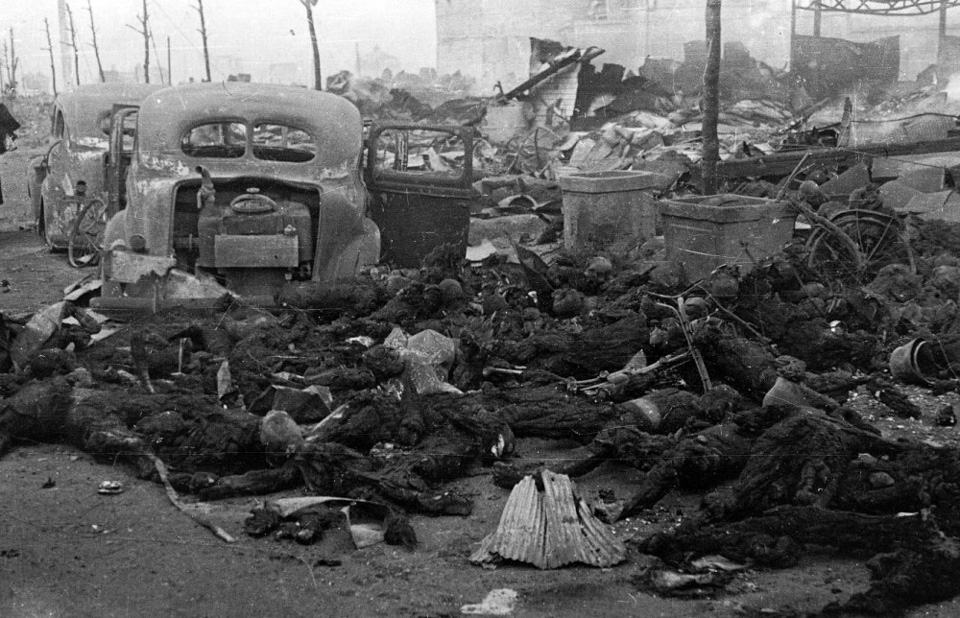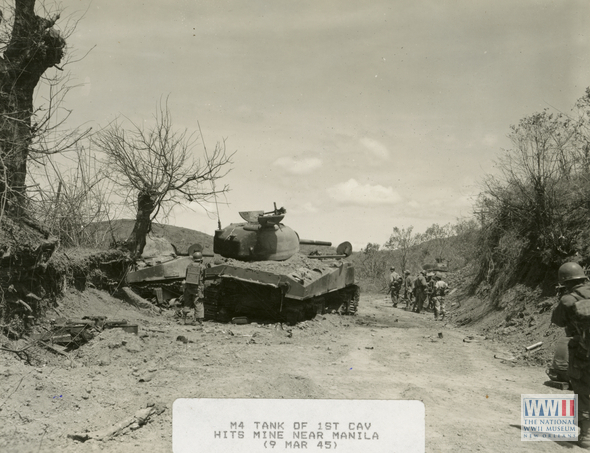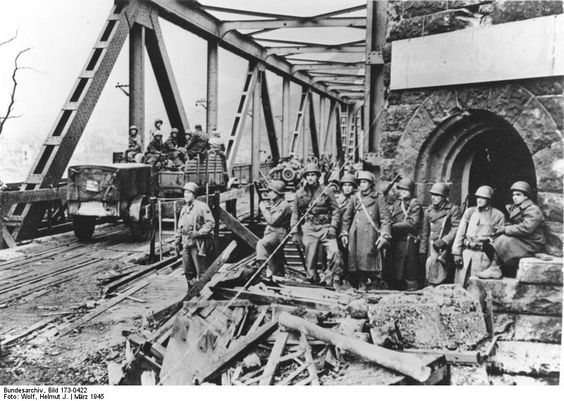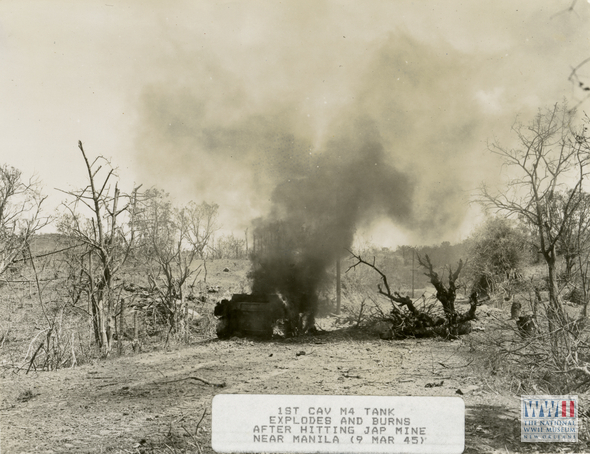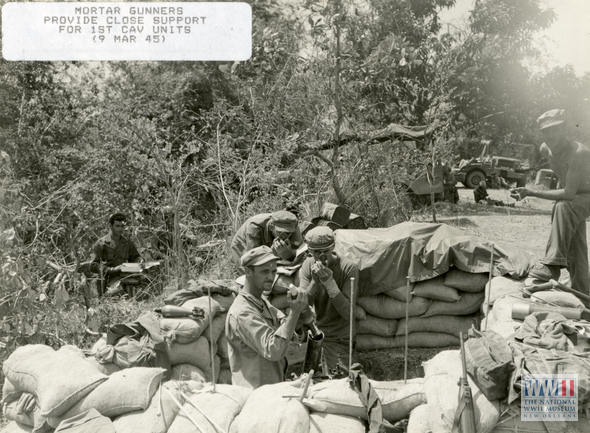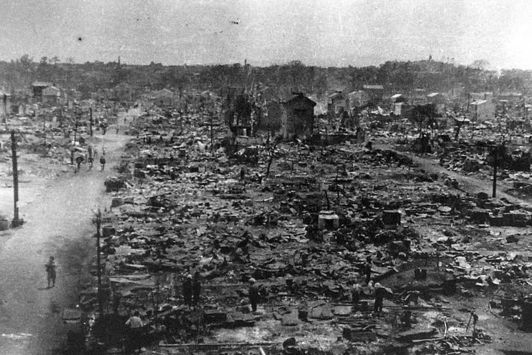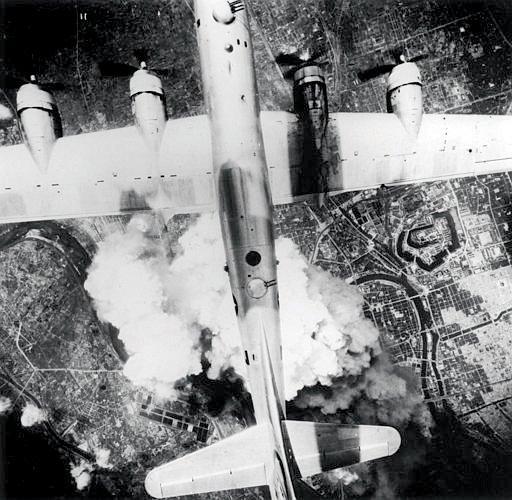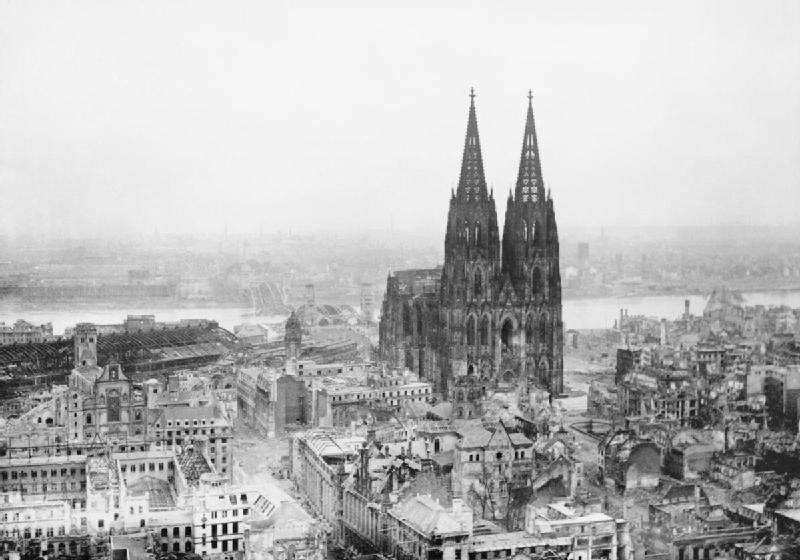Air Operations, CBI
BURMA- More than 80 10th Air Force fighter-bombers attack troops, artillery positions, motor vehicles, and horse-drawn carts directly behind the Japanese Army battle lines.
- 16 P-47s support Chinese Army ground forces near Mansam.
- 31 308th Heavy Bomb Group B-24s and 12 311th Fighter Group P-51s attack the rail yard at Sinsiang and a bridge spanning the Yellow River.
- 15 341st Medium Bomb Group B-25s and 2 P-40s attack bridges at 2 locations and rail targets and targets of opportunity at 4 locations.
- More than 50 fighter-bombers attack troops, artillery positions, transportation targets, bridges, and supplies across southern and eastern China.
- A 51st Fighter Group P-51 downs 2 Ki-43 'Oscar' fighters in a mid-afternoon melee near the Ming Ku Gung airfield at Nanking.
Air Operations, Europe
RAF BOMBER COMMANDDaylight Ops:
- 159 Lancasters of No. 3 Group bomb the North and South plants of the Emscher Lippe benzol plant near Datteln. The target area is cloud-covered and G-H is used. The bombing appears to be accurate, but no results are seen.
- 1 Lancaster is lost.
- 21 Lancasters and 2 Mosquitos of No. 5 Group are sent to bomb the Bielefeld Viaduct, but the raid is abandoned because of low cloud.
Minor Ops:
- 92 Mosquitos are sent to Berlin, and 16 on nuisance flights over Bremen, Hannover, Osnabrück and Wilhelmshaven, 21 Halifaxes lay mines in the Kattegat and off Oslo, and there are 12 Mosquito patrols and 29 RCM sorties.
- There are no losses.
GERMANY:
- 318 1st Air Division B-17s attack a munitions plant and a marshalling yard at Kassel.
- 277 2nd Air Division B-24s attack marshalling yards at three locations.
- 372 3rd Air Division B-17s attack two marshalling yards at Frankfurt am Main.
- 38 3rd Air Division B-17s attack a chemical plant at Frankfurt am Main.
- 7 heavy bombers are lost.
GERMANY:
- More than 600 9th Air Divisin bombers attack marshalling yards at six locations, a munitions plant, vehicle depots, storage depots, and targets of opportunity.
- In a rare show of force, Luftwaffe fighters attack three bomber formations over Wiesbaden and Niederhausen.
- 3 B-26s are lost.
- 9th Air Force pilots down 11 Luftwaffe fighters over Germany between 1157 and 1700 hours.
ITALY:
- 12th Air Force B-25s attack bridges at six locations, a bridge approach, and a marshalling yard.
- XXII TAC P-47s attack supply dumps, parked airplanes, bridges, road and rail traffic, and buildings.
- During the night, XXII TAC A-20s and A-26s attack communications targets in the Po River valley.
AUSTRIA:
- 15th Air Force heavy bombers attack five marshalling yards at four locations and bridges along the Austro-Yugoslav border.
Air Operations, Formosa
V Bomber Command B-24s attack port facilities at Takao.
[Air Operations, Pacific
334(279?) B-29 bombers from Guam, Saipan and Tinian drop incendiary bombs on Tokyo in a massive 3-hour raid. Over 1,650(1667t?) tons of incendiaries (napalm and oil bombs) are dropped on the city in a new form of attack designed specifically to take advantage of the wood and paper construction of many Japanese houses. 10 square miles, a fifth of the total area of the city, are razed to the ground. A casualty figure of 130,000 is reported with about 83,000 dead being confirmed, but some sources put the number as high as 200,000. A million are rendered homeless. It is the most damaging air attack of the war including the atomic attacks on Hiroshima and Nagasaki. This is only the first of many such raids on Japanese cities.
[Air Operations, Philippines
- XIII Bomber Command B-24s, 42nd Medium Bomb Group B-25s, and 347th Fighter Group P-38s attack targets in the Zamboanga area.
- V Bomber Command B-24s attack targets in the Ipo area.
- V Bomber Command B-25s attack Basilan Island.
- B-25s and V Fighter Command fighter-bombers support US 6th Army ground forces on the eastern side of Manila Bay.
- B-25s, A-20s, and fighter-bombers attack the Aparri airfield and several occupied towns on Luzon.
- At 1050 hours, a XIII Bomber Command B-24 in the process of bombing Zamboanga is blown up in the air by a bomb from another B-24. 1 survivor is saved by a US Navy cruiser-launched OS2U.
- A 547th Night Fighter Squadron P-38 downs a reconnaissance airplane over the Tuguegarao airfield on Luzon at 1940 hours.
Allied Planning
Field Marshall Bernard L. Montgomery lays out the final plan for Operation PLUNDER, the 21st Army Group's crossing of the Rhine. The US 9th Army (XIII Corps, XVI Corps, and XIX Corps) is to cross south of Wesel. The XVI Corps will make the initial assault with two divisions; XIX Corps will be prepared to pass through the right of the British 2nd Army and attack toward Hamm-Münster. The XIII Corps will hold along the Rhine. The XVIII Airborne Corps (US 17th Airborne and British 6th Airborne Divisions) are to support the attack at Wesel and expand the bridgehead, capture crossing sites at the Issel River, and then link with 9th Army. 9th Army is well prepared. It has collected 138,000 tons of supplies to support the operation along with 14,000 tons of bridging equipment. Over 600 artillery pieces are in place to support the US divisions. Most of the Allied air support in-theater will be dedicated to the 21st Army Group's crossing.
[Burma
In the British XXXIII Corps sector, the 19th Indian Div penetrates into the outskirts of Mandalay, where bitter fighting develops. Other XXXIII Corps units are advancing toward the city from the west. The fighting around Meiktila is still very fierce as the Japanese continue to bring troops from the Mandalay area in a desperate attempt to free their communications.
[Eastern Front
In Yugoslavia, the Yugoslav 3rd Army launches a counterattack against the bridgehead established over the Drava by the German Army Group E. The counterattack is contained.
In the Vistula Army Group sector, the Russians storm through the defenses of Küstrin (Kostrzyn) and bitter house-to-house fighting develops. The 2nd Belorussian Front pushes on in the Danzig area.
GERMANYThe Soviet 2nd Shock Army captures Marienburg.
HUNGARYThere are now more that 600 panzers committed against the Soviet 4th Guards and 26th Armies, but still the Germans can make little progress. To compound their problems, the Soviets are feeding the 6th Guards Tank and 27th Armies into the line as reinforcements. On the Drava, the Yugoslav 3rd Army goes over to the offensive against Army Group E.[MORE]
[French Indochina
(10th?) The Japanese fearing an American landing, deprive Adm Jean Decoux of all authority as Governor-General of the colony, and dismiss the whole French administration and establish the puppet 'Empire of Annam'. They start on a series of brutal acts which only serve to strengthen the resistance movement. It is in this atmosphere that the Vietminh is born.
[Iwo Jima
During the night large numbers of Japanese with demolition charges tied to their belts thrown themselves against the American positions, achieving some penetration and putting the 4th Marine Div in some difficulty. The suicide attack, which Gen Tadamichi Kuribayashi had forbidden, is repulsed. In the morning the Americans count 784 enemy dead on the ground.
The 3 Marine divisions continue their systematic attacks with flamethrowers and explosive charges against the Japanese caves and other strongpoints. Still held up on the right and in the center, they make good progress along the west coast of the island.
[Philippines
On Luzon hard fighting continues on the Shimbu line, east of Manila, and in the central eatern part of the island.
American aircraft and ships bombard Zamboanga area on the island of Mindanao, in readiness for a landing. American troops are withdrawn from Samar, where the liquidation of the remaining Japanese is left to the Filipino infantry.
[Soviet Union, Strategy
The Stavka is already planning a counteroffensive in Hungary, using the 2nd and 3rd Ukrainian Fronts to attack the 6th SS Panzer Army and Hungarian 3rd Army and capture Vienna.
[Western Front
On the northern flank of the Allied line, the Germans abandon their bridgehead in the area of Wesel and destroy the bridges over the river.
In the Canadian 1st Army sector, the 4th Div, Canadian II Corps, takes Veen.
While the German 15th Army abandons the west bank of the Rhine, Bonn is captured by the units of the US 1st Div, US 1st Army.
Control of the bridgehead at Remagen is taken over by the 9th Div, III Corps. The Germans continue to send aircraft over to try to destroy the bridge. Meanwhile the 7th Arm Div has taken over the defense of the west bank of the Rhine between Bonn and Remagen.
In the US 3rd Army sector, units of the VIII Corps have reached the Rhine at Andernach, while the 4th Arm Div, XII Corps, is ordered to establish a bridgehead at Treis.
[Images from March 9, 1945
|
|
|
|
|
|
|
|
